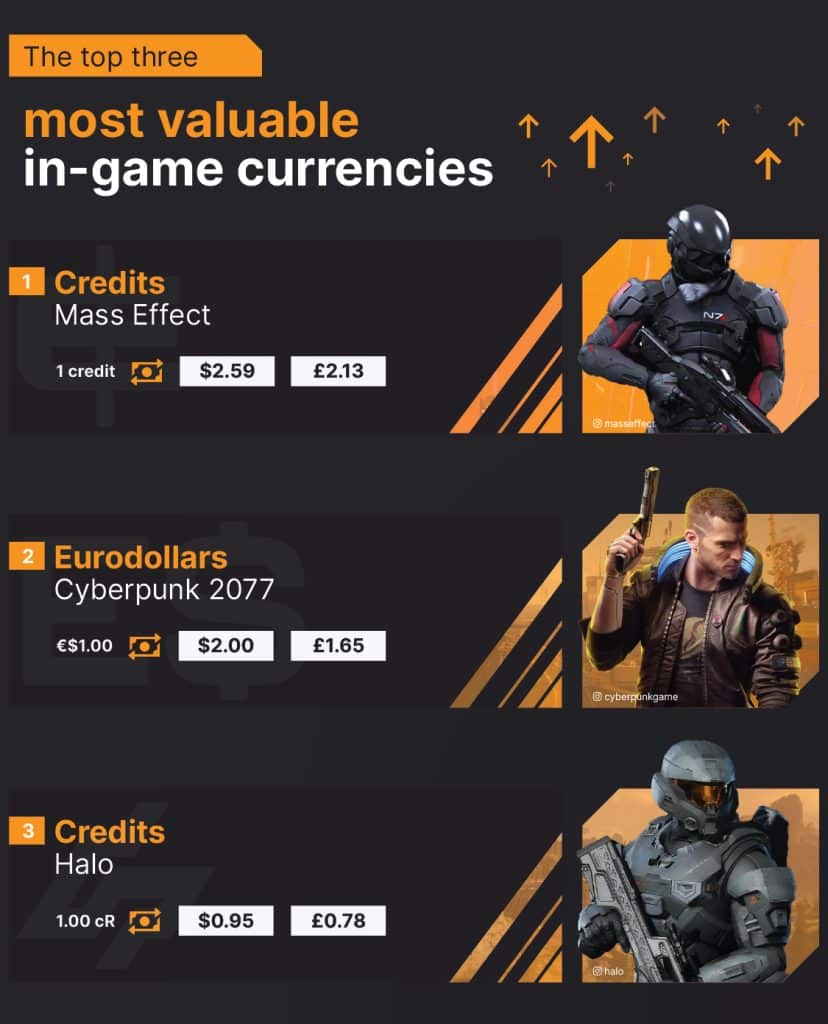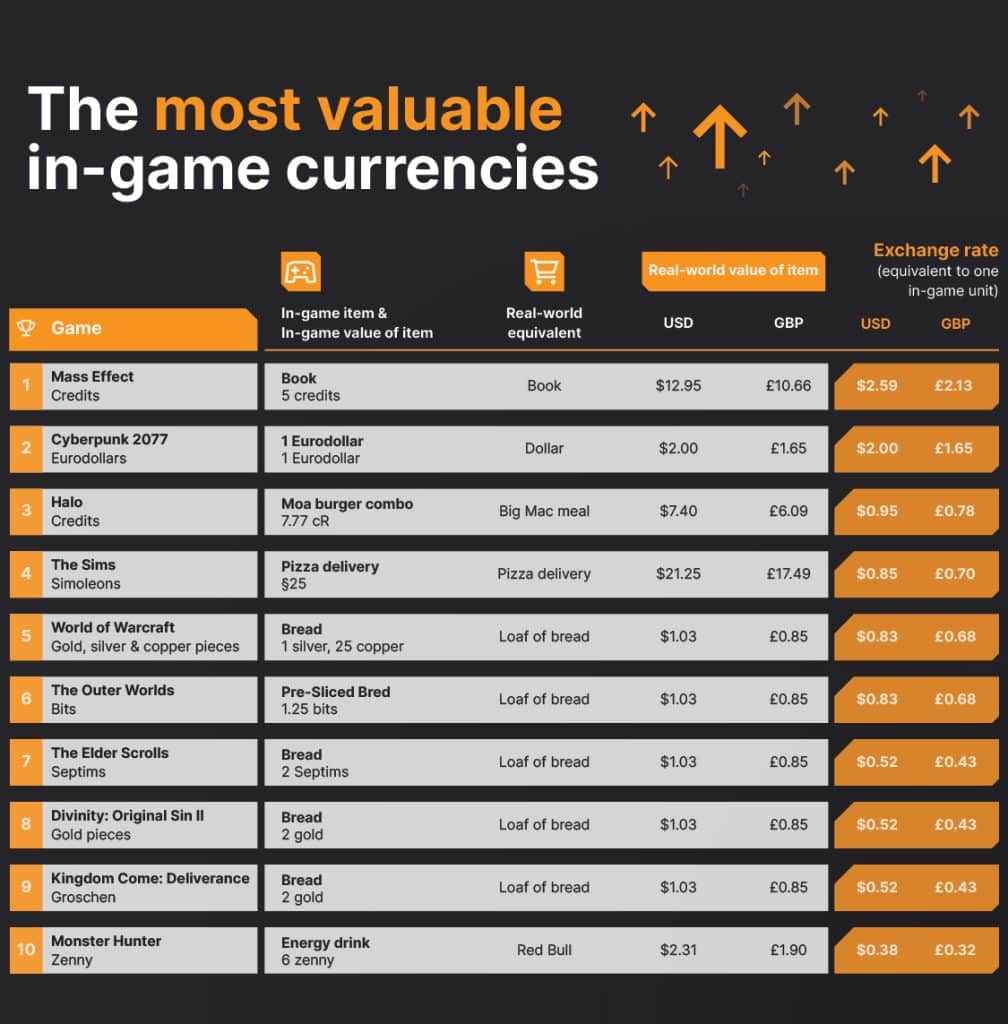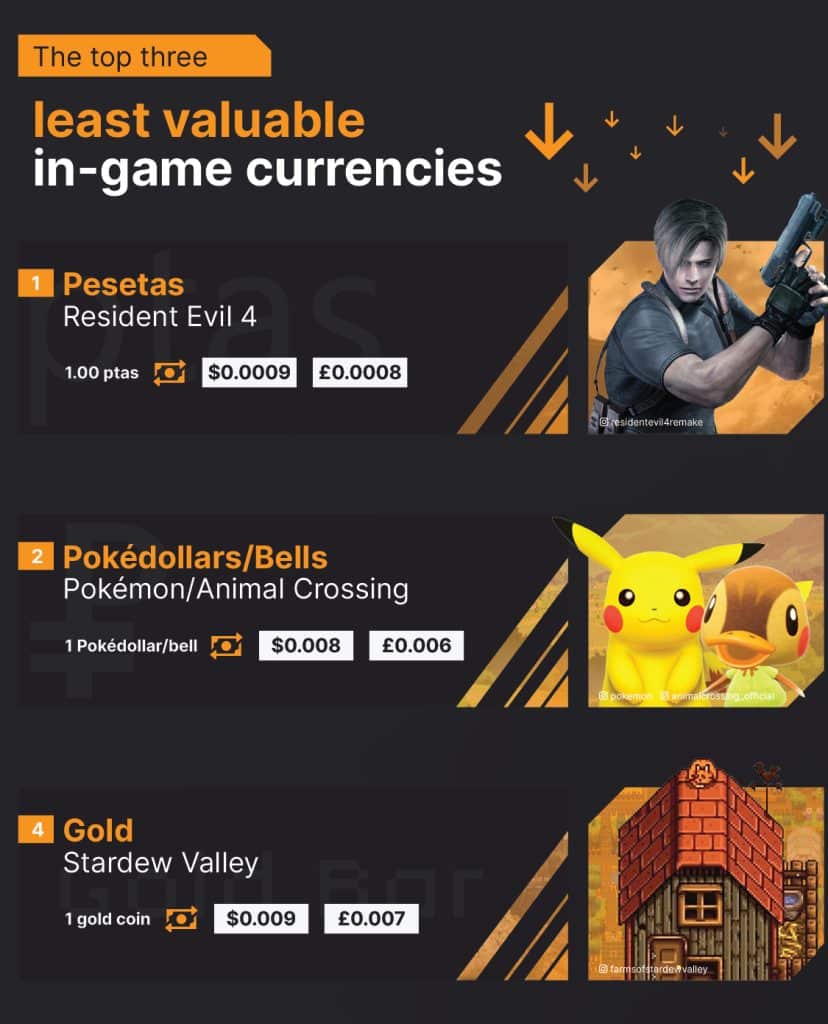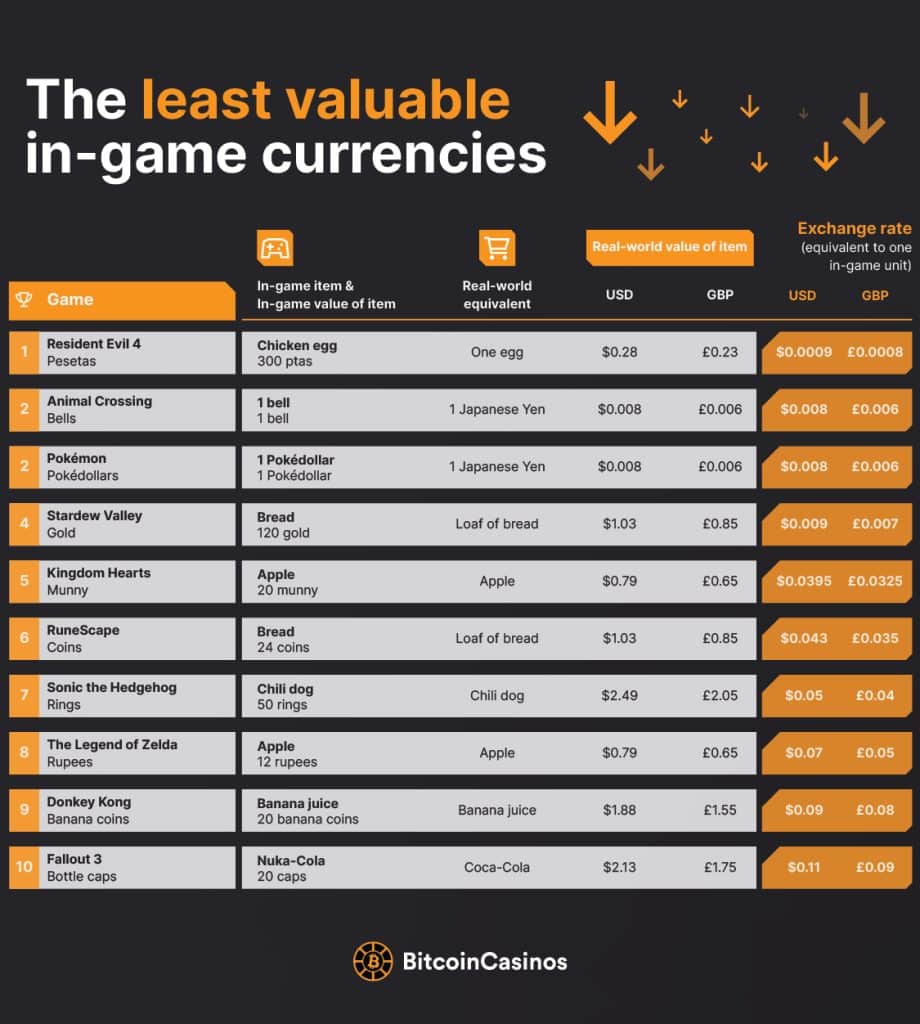Buying items and upgrades for your character has become a key part of video games, with some games now featuring fairly complex economies.
While games that are more grounded in reality may use a real-world currency, many have created their own, similar to the virtual currencies used in Bitcoin casino games.
But how much would these fictional currencies be worth in the real world? While it’s impossible to truly put a value on them, Bitcoin Casinos looked at the in-game values of some real-world items (such as a loaf of bread) to try and estimate how much some of gaming’s best-known currencies would be worth in real life.
How each exchange rate was calculated:
- For each game, we found a real-world item that can be bought in the game and how much it costs.
- We then found a real-world equivalent, as well as its cost in either GBP or USD.
- Finally, the cost of the real-world item was divided by the cost of the in-game item, to estimate how much one unit of in-game currency is worth in GBP and USD.
Please note that these currencies are, of course, entirely fictional and so these comparisons are not perfect and should be treated as light-hearted estimates.
The most valuable in-game currencies
-
Credits – Mass Effect
1 credit = $2.59/£2.13
There are only a handful of gaming universes where the fictional currency is worth more than money in the real world. The best example is Mass Effect.
In the Mass Effect universe, credits are the standard currency used by all space-faring races, with one credit being worth $2.59 (£2.13).
How do we know this? Well, unlike many other games on this list, there aren’t that many real-world items that you can buy in the game.
However, in Mass Effect 2, the player can buy two seemingly pointless books called “Ascension” and “Revelation”, for five credits each.
These are actually the names of two Mass Effect novels that you can buy in real life, for $12.95, meaning one credit is worth around$2.59!
-
Eurodollars – Cyberpunk 2077
€$1.00 = $2.00/£1.65
In Cyberpunk 2077, the world has gone through a major economic collapse and most real-life currencies have ceased to exist, with the eurodollar replacing them.
This currency is commonly referred to in the game as “ebucks” and “eddies” and is used to buy everything from weapons and cybernetic enhancements to food and clothing.
The value of the eurodollar is heavily influenced by the political and economic climate of the game, with different factions and corporations controlling different aspects of the economy.
This is a fairly straightforward one as it’s been explicitly stated that one eurodollar is roughly equal to two modern-day US dollars (although this can vary). This makes the eurodollar one of the most valuable currencies in gaming.
-
Credits – Halo
1.00 cR = $0.95/£0.78
Interestingly, each of the top three gaming currencies can be found in futuristic sci-fi worlds. In the Halo universe, credits are the universal currency used by the Unified Earth Government.
The economy of the game is heavily influenced by the ongoing conflict with the alien Covenant, with military technology and supplies being a major driver of the economy.
While players can’t spend money themselves in the game, we can still estimate how much a credit is worth.
That’s because eagle-eyed fans spotted an advertisement in Halo: Reach for a ‘moa burger combo’ (a moa being an ostrich-like creature), at 7.77 cR.
Assuming that such a meal is comparable to a real-world Big Mac meal from McDonald’s, this would mean that 1cR equals $0.95 (£0.78).
The least valuable in-game currencies
-
Pesetas – Resident Evil 4
1.00₧ = $0.0009/£0.0008
However, not all gaming currency units hold such a high value. In Resident Evil 4, pesetas are the currency used by the game’s merchants to buy and sell items.
Of course, pesetas were the real-life currency of Spain before the euro, but in this fictional universe, it seems their value is a lot lower.
The economy of the game is heavily influenced by the player’s ability to scavenge for items and weapons, with ammunition and health items being particularly valuable.
One such item is chicken eggs, which can be sold for 300₧. In real-life a pack of six eggs costs around $1.70 (£1.40), putting the cost of a single egg at about $0.28 (£0.23).
This would mean that a single peseta from Resident Evil 4 is worth a measly $0.0009 (£0.0008).
-
Pokédollars/Bells – Pokémon/Animal Crossing
1 Pokédollar/bell = $0.008/£0.006
Two currencies are tied in second place. That’s because the currencies used in both Pokémon and Animal Crossing are directly comparable to the Japanese currency, the yen.
While we can’t relate this to fictional in-game items such as potions, the value does seem to match up with real-world equivalents such as a bottle of water, which costs 200 Pokédollars in the latest Pokémon games and would equal around $1.49 (£1.22).
Similarly, players in Animal Crossing: New Horizons could buy a Nintendo Switch for 29,980 bells, with the console launching for exactly 29,980 yen in Japan in 2017.
-
Gold – Stardew Valley
1 gold coin = $0.009/£0.007
Stardew Valley is a popular farming simulation and role-playing game where players inherit a run-down farm and must cultivate crops, raise animals, mine resources, and build relationships with the townsfolk.
In the game, gold is the currency used by players to buy and sell items, upgrade their farms, and participate in festivals and events.
In the game, players can purchase a loaf of bread for 120 gold coins. A loaf of bread currently costs around $1.03 (£0.85) in real life, giving this currency an estimated value of $0.009 (£0.007).
Methodology
For each game, a purchasable in-game item that also has a similar real-world equivalent was chosen.
The prices of both the in-game item and its real-world counterpart (in GBP and USD) were taken from various sources such as fan Wiki sites and articles.
The real-world price was then divided by the in-game price to estimate the conversion rate between the two.
It’s important to note that these comparisons are not perfect, as in-game economies and items can differ greatly from their real-world counterparts.




